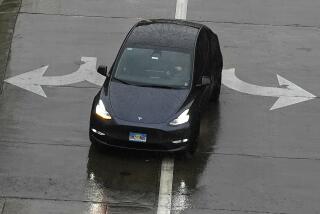Auto sales stay lackluster as carmakers spend little on incentives
Consumers facing fewer choices and higher prices throttled back on vehicle purchases, dampening auto industry sales in June.
Automakers sold more than 1 million vehicles last month, up 7% from a year earlier but down slightly from May, according to Autodata Corp., an auto industry information company.
The industry is bumping up against hesitant shoppers such as Kirstin Stone, a recent college graduate who wants to replace her 1994 Toyota truck with 175,000 miles on the odometer.
“Car prices are crazy right now. I might wait for the end of the model year,” said Stone, who lives in Riverside and expressed frustration with several shopping trips to dealers.
Stone, 22, graduated from UC Davis this year. She said she was frustrated by the dearth of rebates for recent college graduates — once an industry standard.
Stone’s delaying tactic may work out, said Jeff Schuster, an analyst at the J.D. Power & Associates consulting firm. Prices should ease in late August or in September as the supply disruptions caused by the Japan earthquake in March start to ease, he said.
“We will see deals because the automakers will want to let buyers know the industry is competitive again,” he said.
On Friday, California buyers began getting a price break from a reduction in the sales tax and vehicle registration fee, passed in the state’s new budget. A buyer of a $25,000 vehicle will pay $250 less in sales tax because the tax rate fell 1 percentage point. The annual registration fee dropped to 0.65% of a car’s value from 1.15%, saving that buyer an additional $125.
Automakers viewed the tax change as positive news for the industry because California is the nation’s largest auto market.
“Once [California] consumers see how that plays out, that will start to drive demand,” said Don Johnson, General Motors Co.’s vice president of U.S. sales operations.
Ford Motor Co. said the anticipation of lower taxes in California caused a noticeable softening in sales in June as people delayed purchases to take advantage of the rate cut.
But nationally the recent increases in sticker prices and reduction in incentives has put the brakes on auto sales growth, said Jessica Caldwell, an analyst at auto information company Edmunds.com.
Incentive spending rose a slight 2% from May to an average of $2,165 per vehicle, according to Edmunds.
The increase was mostly a result of better offers by Toyota and Honda as quake-related disruptions looked to ease. Still, the amount of money automakers spent on incentives last month was down more than $500 per vehicle on average, almost a 20% decrease, from June 2010, Edmunds.com estimated.
“Despite the increases, overall incentive spending across the automotive industry continued at a very conservative pace in June,” Caldwell said. “We haven’t seen a run of spending this low in almost a decade.”
What’s missing from the market are the more impulse-oriented and emotional buyers who “want” to buy a car rather than those who must buy because of expiring lease contracts or aging vehicles that need to be replaced, said Jesse Toprak, an analyst with TrueCar.
The current crop of buyers includes people like Noah Keith, a Buena Park electronics technician, who paid $27,000 last month for a fully loaded Ford Focus to replace a 1989 Honda Civic that had almost 270,000 miles on the odometer.
“My Honda was getting to the point where it was more money to fix than it was worth. Replacing it was a necessity,” said Keith, 39.
Keith’s switch from a Honda to a Ford represented gains that domestic automakers are making over Japanese rivals. Especially notable was the ability of Ford and GM to gain sales in the passenger-car segment of the market over the Japanese automakers, which have dominated that sector, analysts said. The domestic brands have traditionally been stronger in truck and SUV sales.
Keith considered but rejected compact sedans from Mazda and Honda.
The big Japanese automakers continue to struggle with inventory and production problems caused by the March earthquake disaster.
Through the first half of the year, the share of the U.S. auto market held by Toyota Motor Corp. slid to 12.8% from 15.1% in the same period a year earlier. Honda Motor Co. saw its share drop a full percentage point to 9.6%. Meanwhile, the share of the market held by the American brands rose to 46.8% from 45.6%.
Toyota’s U.S. sales in June fell 21.1% from a year earlier, to 110,937 vehicles. Honda sales fell 21.3%, to 83,892 vehicles. Both Toyota and Honda have said that their factories are starting to rebound toward normal levels and that their supplies of cars should increase in the coming months.
Meanwhile, GM’s U.S. sales rose 10.6% in June, to 215,335 vehicles, according to Autodata. Ford’s June sales rose 13.3%, to 193,415 vehicles. Chrysler Group sales rose 30.2% to 120,394.
South Korean manufacturer Hyundai and its sister automaker Kia also have made large gains in the U.S. Their combined market share for the first half of the year was 9%, which put them ahead of Nissan and just behind Honda.
More to Read
Inside the business of entertainment
The Wide Shot brings you news, analysis and insights on everything from streaming wars to production — and what it all means for the future.
You may occasionally receive promotional content from the Los Angeles Times.










